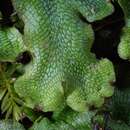en
names in breadcrumbs


Marchantiales is an order of thallose liverworts (also known as "complex thalloid liverworts") that includes species like Marchantia polymorpha, a widespread plant often found beside rivers, and Lunularia cruciata, a common and often troublesome weed in moist, temperate gardens and greenhouses.
As in other bryophytes, the gametophyte generation is dominant, with the sporophyte existing as a short-lived part of the life cycle, dependent upon the gametophyte.
The genus Marchantia is often used to typify the order, although there are also many species of Asterella and species of the genus Riccia are more numerous. The majority of genera are characterized by the presence of (a) special stalked vertical branches called archegoniophores or carpocephala, and (b) sterile cells celled elaters inside the sporangium.
Based on the work by Villarreal et al. 2015[2]
Marchantiaceae Dumortieraceae Aytoniaceae Cleveaceae Monocleaceae Conocephalaceae Oxymitraceae Ricciaceae Targioniaceae Wiesnerellaceae Monosoleniaceae Cyathodiaceae CorsiniaceaeExtinct complex thalloid liverworts are often represented by coalified compressions that preserve superficial morphological traits and do not allow exhaustively analysing their fine anatomy; though, in exceptional cases, fossils might preserve cell details.[3]
Generally speaking, extinct Marchantiales - which commonly date back to the Mesozoic - can be grouped in Marchantia-like and Riccia-like fossils according to their overall morphology. While the phylogenetic relationships among many extinct and extant Marchantiales remain equivocal, it has been suggested that some fossils are closely related to extant Marchantiales.
Marchantites cyathodoides (Townrow) H. M. Anderson (Middle Triassic), for instance, is a Marchantia-like fossil whose detailed morphological characters (e.g., thallus with midrib, reduced air chambers, rhizoids and ventral scales) suggest a nested position within Marchantiales.[4] Some Riccia-like fossils have even been assigned to families based on their overall morphology and branching patterns, such as the case of Ricciopsis sandaolingensis Li & Sun (Middle Jurassic[5]). The first phylogenetic analyses that include both extinct and extant Marchantiales have further clarified the relationships among these taxa and have revealed new relationships among families.[6] Likewise, the inclusion of fossils in total-evidence analyses implied that some groups of complex thalloid liverworts might be older than previously inferred.
Summary tree based on the work by Flores et al. 2020:[6]
Marchantiophyta JungermanniopsidaPallaviciniites sandaolingensis +
Metzgeriidae Marchantiopsida Marchantiidae Marchantiales Marchantiaceae RicciaceaeTaxonomy based on work by Söderström et al. 2016[7] and synonyms from Collection of genus-group names in a systematic arrangement.[8] The order Lunulariales, proposed by Long 2006,[9] has been recently re-included in Marchantiales as a family.[10][11]
{{cite journal}}: Cite journal requires |journal= (help) Marchantiales is an order of thallose liverworts (also known as "complex thalloid liverworts") that includes species like Marchantia polymorpha, a widespread plant often found beside rivers, and Lunularia cruciata, a common and often troublesome weed in moist, temperate gardens and greenhouses.
As in other bryophytes, the gametophyte generation is dominant, with the sporophyte existing as a short-lived part of the life cycle, dependent upon the gametophyte.
The genus Marchantia is often used to typify the order, although there are also many species of Asterella and species of the genus Riccia are more numerous. The majority of genera are characterized by the presence of (a) special stalked vertical branches called archegoniophores or carpocephala, and (b) sterile cells celled elaters inside the sporangium.